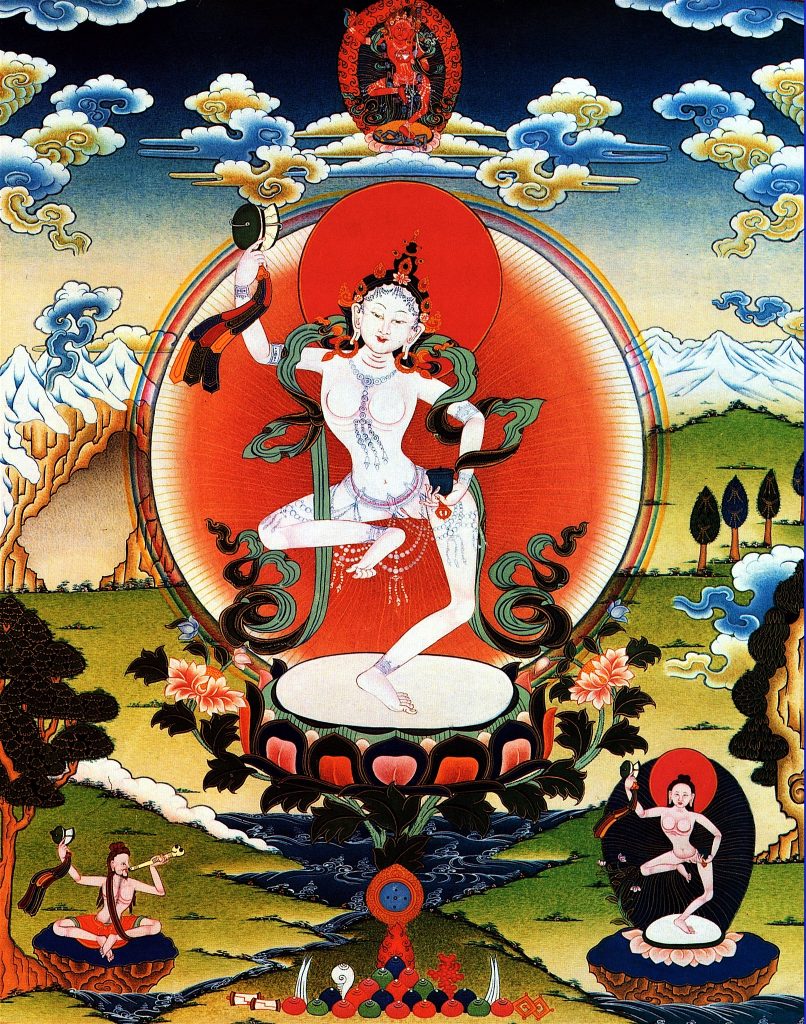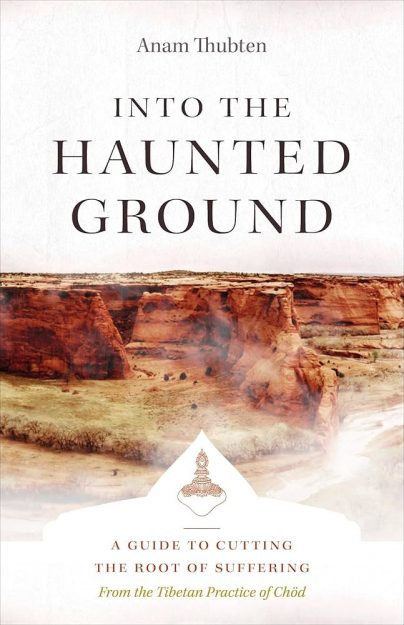Fear and resistance are often the forces that hinder our inner growth, holding us back from experiencing a greater sense of freedom and from exploring the endless magic of existence. Moving beyond them creates the possibility of not living in the cocoon of comfort and habits. We often take refuge in a comfortable physical environment and in familiar realms of consciousness. From these places, we do not dare to enter the unknown and become locked up in a habituated internal and external world. Sometimes this habituated world can be quite comfortable, but at the same time there is an abundance of suffering in it. It continues until the roots are cut. People choose life lived in this familiar realm and get very attached to it, which then strengthens their resistance to exploring the unknown world. Here, [11-century Indian yogi and spiritual master] Padampa advises [female Tibetan Buddhist monk and founder of the Chöd of Mahamudra] Machig Labdrön to invite the unknown and to drop fears and resistance right on the spot, immediately. Chöd is about intentionally inviting and embracing the unknown, facing it, then dropping all resistance to it.
To “trample” is to tread on and crush—to destroy on the spot. It is an immediate approach without hesitation or mercy, directly confronting and conquering fear and resistance. There is a sense of testing your edge. The truth is that we have an extraordinary ability to conquer our resistance if we have the will to do so. Most of us may be able to remember that there have been life challenges we thought we could not overcome. At those times, we may have found the will to conquer them with a sense of triumph. Those moments of triumph can be an empowering reminder that, with commitment and willingness, we have the ability to overcome our challenges.
Trampling is a powerful image for bringing whatever is intimidating you under your foot—trampling on it with humor and fearlessness. To meet fear directly and radically without analysis often requires a great deal of courage. It is based on the view that the challenges are created by ego rather than having any intrinsic reality. With that view, the commitment is to not give in to ego or its delusions and confusions. You sense that you are no longer your ego, even though you have been experiencing fear, resistance, and everything that ego constructs as your reality. Then, there is space between you and your ego, and you have the ability to break the ego’s shackles on your consciousness.
In general, there are two ways of working with challenges. The first is the gradual process of recognition. Typically, many people use psychological and spiritual analysis—journaling or talking to a therapist or spiritual mentor—as ways to address their fears and inner demons. No doubt, deeper self-awareness develops through this approach. But at some point, it becomes like chewing on the issues, an obsession in itself—almost like the problems are talking about themselves.
Here, Padampa is not suggesting the gradual self-help approach. From the point of view that our mind’s nature is already free, Padampa is presenting a second method—radically and directly facing your challenges. You do not indulge them but go straight into them to conquer them. He is not demanding an impossible mission but is just reminding us that all we need is to be free from the self-imposed trap of ego, because many of our challenges are simply part of ego and do not exist in the realm of reality itself.
We do not have to go looking for resistance and challenge; there is plenty of it in us. So whatever challenge shows up, the moment you recognize it, trample on it on the spot. The point is that if you are resistant to letting go of fear, just let go of it. If you are afraid of love, just let go of your resistance to it. Open your heart and take in the soft and nurturing outpouring coming toward you. If you are afraid to speak in public, just take your seat and use your voice— say what is true and meaningful. Someone once asked Shunryu Suzuki Roshi, a famous Japanese Zen teacher, “What is hell?” He replied, “Hell is having to read aloud in English.” What challenges you may not be a challenge to someone else. We human beings are distinct from each other, beyond our commonalities as a species.
We are all creatures of complexity!
One time a friend of mine had trouble with someone he worked with. As we all know that when a friend tells us about something like this, we tend to immediately jump on our friend’s side, even if we are not asked. We may begin to judge the other person without ever having met them. Ego loves to take sides. But my friend gently said, “He is a creature of complexity.” This showed he was insightful and not reacting to the difficult coworker but recognizing his issues without taking them personally. We are all creatures of complexity! We are born with karma and are neurologically, genetically wired to react in certain ways, and then we are influenced by nature and nurture. Biological, cultural, and social circumstances make us prone to different strengths and challenges. Nonetheless, it is by trampling on whatever our unique limitations are that we find the freedom to compassionately understand others with this all-encompassing wisdom of human conditions.
A whole host of fears visit us every day. Usually they show up as stress, depression, and nagging anxiety. Your friendships or relationship may be filled with pain, with serious betrayal or miscommunication, but you may be afraid to open a direct and honest discussion about it. Your fear makes reconciliation and understanding impossible. From this fearful place, friendship cannot be restored but can be lost for years. Our ego has thousands of strategies for avoiding conflict, such as ignoring, being busy, cocooning in our spiritual practice, indulging in mindless entertainment, or engaging in gossip to numb ourselves. Sometimes, ready or not, life forces us to trample on challenges, even without ceremony or ritual or help from a master. We may have to jump, regardless of our paralyzing fear. There are times for other more elaborate methods, but this simple and direct strategy often works. We also have to acknowledge who we are, that we are not superhuman beings able to transcend all limitations, and that there is vulnerability in us that has to be cherished. Sometimes we are not able to cut through right on the spot, and sometimes we are.
When I was young, I was very heady and loved to study. By contrast, many of the boys in my village were more physical and reveled in taking risks. But I was more domestic and did not play in the landscape, testing myself against nature like they did. One time I heard that while the boys were in the mountains herding their yaks, one strayed away from the herd. The village boys heroically searched for it, slept in the mountains all night, and did not return until morning. At the time, I was impressed that they could do this, because to me it was a scary scenario and I could not imagine doing it myself. Sometime later, on a nighttime journey through the dark Himalayan landscape, I met this fear again in a way that I could not avoid. I was traveling with a few people, and we had to cross a narrow bridge over a strong flowing river. It was the only way across the river, and turning back would have been a failure in my mind. Having dealt with this sort of situation before, my friends easily crossed the bridge. I was so scared, though, that I felt I could not do it. I was shaken with the fear of falling, being injured, or dying. Fear rushed through my system, my body shook, and I recited some prayers. While the prayers helped me calm down, they did not make my feet move. Finally, I heard a voice in my head say, “Just do it! There is no turning back!” So, I did. I crossed without falling down.
For many people this would not be a big deal, but for me it felt like a symbolic initiation. Something happened in me after that experience—a feeling that I could trust myself to be strong when necessary. This is not something I should brag about, because by many people’s standards this challenge is not a big deal at all. Most people have had similar experiences of running into difficulties and overcoming their usual egoic blocks against being brave and wise. By encountering these and overcoming them, you begin to trust in yourself. You may not even be conscious that you are developing this trust.
What Padampa is saying is that stepping into what challenges us can help us intentionally let go of fears on the spot. You must hold an attitude of sacred confidence, or heroism, and make a radical change in your consciousness. This will give you freedom from the shackles of fear. Trampling on challenges is also about encountering and conquering our limits. For example, you may be afraid of heights without even knowing it. You might like to find out where the edge of that fear is and then do something radical to test and overcome it instead of letting it run your life. This is not encouragement to become a reckless daredevil just to prove something to yourself. Daredevil behavior is simply another trap of ego—proving dominance over danger. The egoic motivation is to prove that you are stronger or have more physical prowess than the average Joe. But with genuine motivation, the whole process becomes an inner initiation through which you develop a new level of courage. This will have a positive impact in your life.
♦
From Into the Haunted Ground: A Guide to Cutting the Root of Suffering by Anam Thubten © 2022. Reprinted in arrangement with Shambhala Publications, Inc. Boulder, CO.
Thank you for subscribing to Tricycle! As a nonprofit, we depend on readers like you to keep Buddhist teachings and practices widely available.

